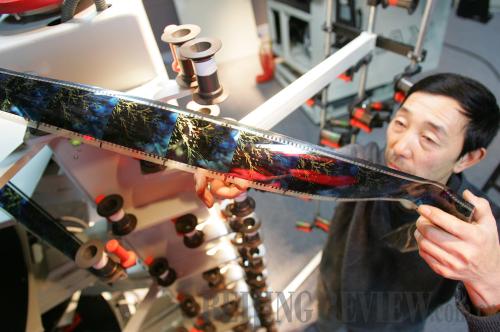|
Since last July, the studio and the Heilongjiang Animation Base have worked together on converting Fishing Child into a 4D version using the newest technology. The project took them three months and cost 6 million yuan ($882,353).
Fishing Child was revived in five steps: First, copies of the original drawings were made. Second, wood or clay figurines for the characters were produced. From this step on, the work was done on computer. "To put it simply, we first draw the characters' bone structures, and then put flesh on them," said Li. Choosing costumes was the third step, animation was the fourth step, and the last step was dubbing.
Several further 3D or 4D films that his company has converted from classics are in the post-production stage, Li said. These include Panda's Department Store, the Vagrant Life of Sanmao and Zhu Bajie Eats Watermelon. They will be released in Beijing and Shanghai in March 2010.
Li's company is also developing 3D technology for cellphones. "Our goal is to build a Chinese 3D film database. In the future, viewers can see these classic films in 3D format in cinemas or on cellphones," he said.
 |
|
NEW ENJOYMENT: A staff of China National Film Museum loads films on to a 4D projector (YANG SUYAO) |
Fishing Child was unveiled to the public in the new 4D cinema of Shanghai Animation Film Studio. The cinema is equipped with the "newest technologies in the world." As the film starts, viewers see a lotus in the treasure plate unfolding in front of their eyes, and a fishing child dressed in a red sash jumping out of the petals.
The new cinema could be turned into a tourism resource, said Zheng Hu, Deuty Director of the studio. In the future, the studio would like to build small 4D cinemas in the recreation areas of large shopping malls, such as the showrooms in Disneylands, to feature short 3D animated films with the running time of around 20 minutes.
In Shanghai, more than 10 teams are able to produce stereoscopic films. Investment in the industry has also grown several-fold and is no longer a problem. Wang said the films were about both technology and ideas, so good stories were needed to match advanced technology, in order to generate good returns from the market.
Creative technologies
Shooting has started on a 4D film adapted from Uproar in Heaven, an animation series released by the Shanghai studio in 1961 and 1964. The protagonist, Monkey King, has been a household name in China. Shenyang 4D-Vision Technology Co. Ltd. and the Shanghai studio are working together to produce the 4D version. In the new version, Monkey King will surely make a bigger stir.
Shenyang 4D-Vision Technology Co. Ltd. has independently developed technology to convert 2D images into 4D ones. "This technology can convert all existing films into stereoscopic films," said Zhao Ruifen, General Manager of the company. This optical fiber autostereoscopic technology had the potential to revive a large number of films, Zhao said.
Technology can dramatically reduce the cost of making these types of films. As an example, Zhao said the production cost of a 90-minute stereoscopic film with the technology used in Avatar was about 10 times that of an ordinary film, and production time was about four years, while her company's technology could cut the production costs to one 600th, and shorten production to a year and a half, and even to half a year as the technology was upgraded further.
This cutting-edge technology was invented by Liu Jianjun, a professor at the China Central Academy of Fine Arts. Liu says he thinks converting 2D images into 3D images is the future direction of the industry and there would be a big market for excellent but low-cost 4D movies.
In 2008, Liu worked with Paramount DreamWorks to develop and publish the world's first stereoscopic film book Shrek the Third. The "book" consists of eight high-fidelity picture cards, a stereoscopic box and a movie props pictorial. By inserting a card into the box, readers can view vivid stereoscopic pictures. Warner Bros. and Disney are also partners of Shenyang 4D-Vision Technology Co. Ltd.
In fact, 4D films and cinema equipment made in China have been distributed to many parts of the world. "Now, our films are shown on more than 70 stereoscope theaters all over the world every day," said Shang Linlin, Assistant to the General Manager of Huaqiang Holdings Ltd., one of China's top 500 enterprises. The company, founded in 1979, has been developed in the industry for more than a decade.
The company not only has a large amount of products, to which it owns the intellectual property rights, but also core techniques that lead the industry, says the company's website. The company has developed 4D theaters, spherical screens, IMAX screens and water-curtain screens and has produced more than 40 4D movies.
In 2000, the company independently developed a 180-degree cylindrical screen theater, FantaWild, and in 2002 successfully patented it in the United States. | 